Conditions for Non-Eligibility for Housing Loan Deduction Application
- For:
- Administrators
- Plans:
- Simple HRHR Essentials0 YenHR Strategy
This article explains when you are not able to create an application form for housing loan deductions using SmartHR's year-end adjustment feature.
We also introduce specific examples of what kind of answers lead to non-eligibility for creating the application form via SmartHR.
- Non-eligibility conditions
- You cannot apply for housing loan deduction via year-end adjustment if:
- You cannot create a housing loan deduction form via SmartHR if:
- (*1) If you have multiple joint liability loans
- (*2) You are applying for deductions for both home purchase and renovation, with dates listed in both column イ (I) and column チ (Chi)
- (*3) Your housing loan deductions application has amounts split into two levels for each item, or when paperwork is split across two pages (If you have more than one Housing Loan Deduction)
- (*4) If you are applying for multiple deductions at once (in the case of special exemptions, 特例)
- (*5) If you started living in the home from 2019 onwards, have the relevant forms, and have different joint liability percentages listed in “家屋に関する連帯債務割合(ニ欄)” (Joint liability ratio for the house, Column Ni) and “土地に関する連帯債務割合(ト欄)” (Joint liability ratio for the land: Column To)
- (*6) If you started living in the home in 2018 or earlier, have the relevant forms, and have a strikethrough in section 14 of your home loan deduction application form
- (*7) If an amount is listed under “特定増改築等の費用の額” (Sum of expenses for specific improvements or additions)
- Three cases where questionnaire responses make an employee ineligible to create the application
- What to do if you cannot create the application via SmartHR
Non-eligibility conditions
An employee is not eligible to create a housing loan deductions application if they meet any of these conditions.
You cannot apply for housing loan deduction via year-end adjustment if:
- You who took out a housing loan this year (2025) and are in their first year after moving (*)
- Your housing loan deduction period has already ended
- You are not living at this house as of December 31 of this year (2025) (does not include temporary situations such as moving away from your family for work)
- Your date of residence is before December 31, 2021 and your total earnings exceed 30 million yen
- You began living in this house on or after January 1, 2022 and your total earnings exceed 20 million yen
- Special Conditions Acquisition (特例特別特例取得) deduction category applies to you and your total earnings exceed 10 million yen
- Special Residential Property (特例居住用家屋) or Special Certified Housing (特例認定住宅等) deduction category applies to you and your total earnings exceed 10 million yen
- If you have refinanced your loan with a repayment period of less than 10 years
(*) You cannot declare their housing loan deductions via the year-end adjustment in your first year. Instead, you must file a final tax return (確定申告).
You cannot create a housing loan deduction form via SmartHR if:
- You have refinanced your loan through multiple financial institutions
- You have multiple joint liability loans (*1)
- You are applying for deductions for both home purchase and renovation, with dates listed in both column イ (I) and column チ (Chi) (*2)
- Your housing loan deductions application has amounts split into two levels for each item, or when paperwork is split across two pages (If you have more than one Housing Loan Deduction) (*3)
- If you are applying for multiple deductions at once (in the case of special exemptions, 特例) (*4)
- You are borrowing from three or more financial institutions
- If you started living in the home from 2019 onwards, have the relevant forms, and have different joint liability percentages listed in “家屋に関する連帯債務割合(ニ欄)” (Joint liability ratio for the house, Column Ni) and “土地に関する連帯債務割合(ト欄)” (Joint liability ratio for the land: Column To) (*5)
- If you started living in the home in 2018 or earlier, have the relevant forms, and have a strikethrough in section 14 of your home loan deduction application form (*6)
- If any amount is listed under “特定増改築等の費用の額” (Sum of expenses for specific improvements or additions) (*7)
- If you need to print an address that is different from your Certificate of Residence (住民票) address on the Housing Loan Tax Credit declaration (e.g. living away from family for work)
(*1) If you have multiple joint liability loans
This applies if you have loans from multiple financial institutions and each loan is a joint liability (連帯債務).
As an exception, you can create it only if the conditions below are all met. Rules depend on when you started living in the home.
Residence started in 2018 or earlier
- Exactly two lending institutions
- Same joint debtors on both loans
Residence started in 2019 or later
- Exactly two lending institutions
- Same joint debtors on both loans
- Same joint-liability ratio across all loans
For details, refer to the below help pages.
(*2) You are applying for deductions for both home purchase and renovation, with dates listed in both column イ (I) and column チ (Chi)
Applies if there is a date printed in the sections circled in red.
| Format after 2020 | Format before 2020 |
|---|---|
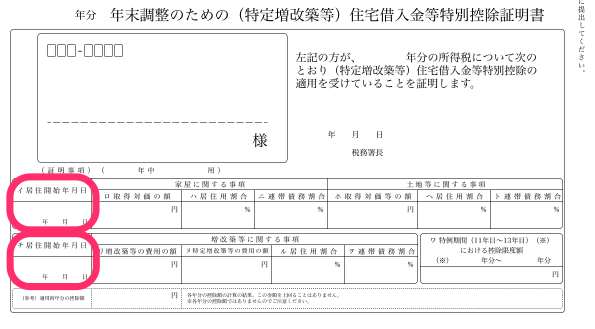 画像を表示する 画像を表示する | 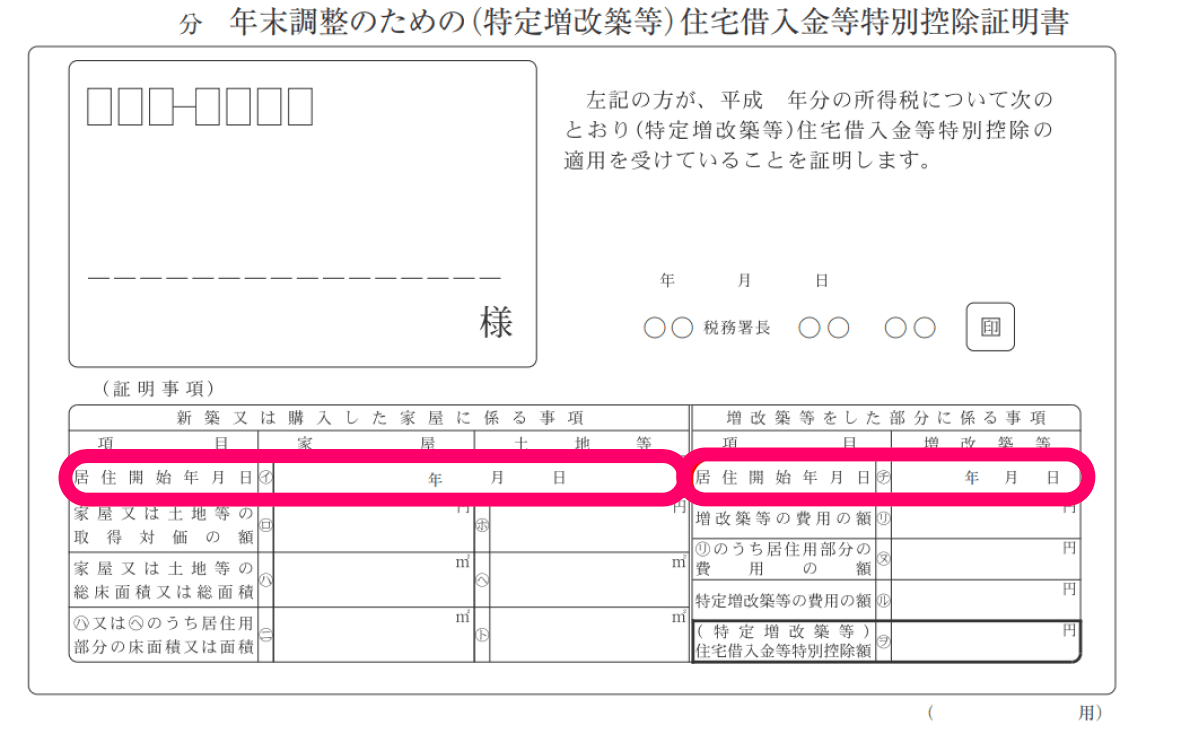 画像を表示する 画像を表示する |
(*3) Your housing loan deductions application has amounts split into two levels for each item, or when paperwork is split across two pages (If you have more than one Housing Loan Deduction)
Applies if the amount circled in red is written in two separate rows, or if there are any documents split across two sheets.
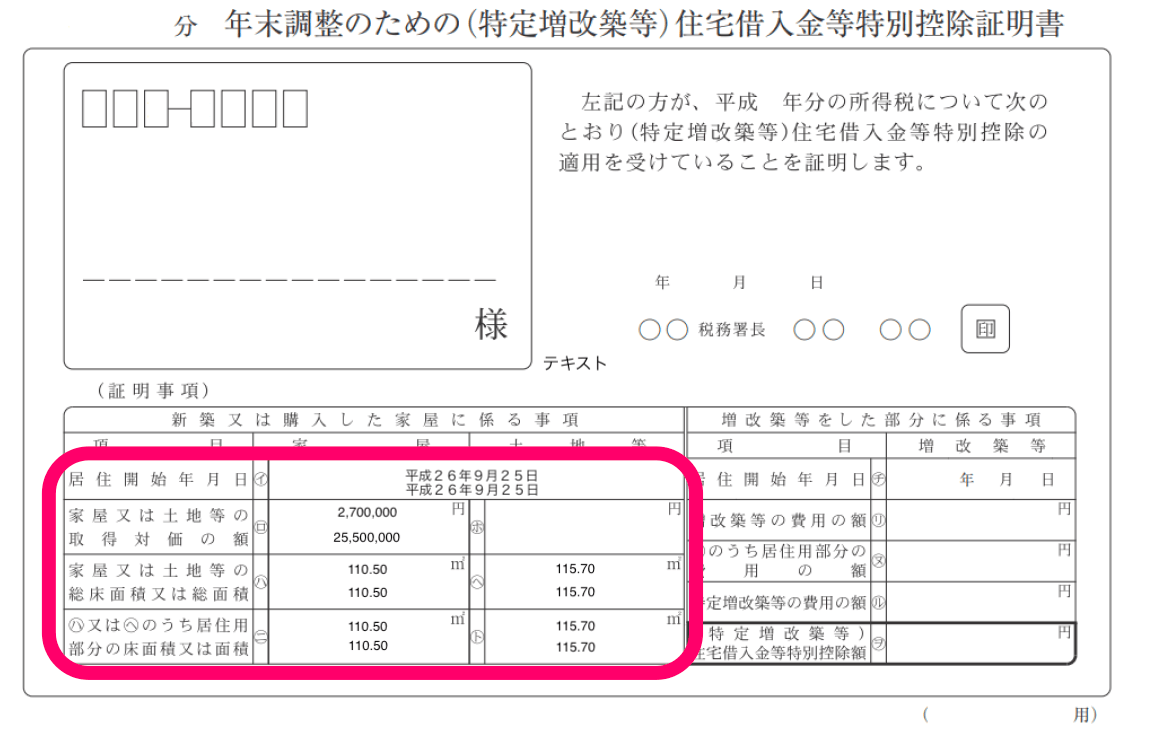 画像を表示する
画像を表示する
(*4) If you are applying for multiple deductions at once (in the case of special exemptions, 特例)
For more details on the special exemptions for duplicate deductions, see Ⅰ‐3 住宅借入金等特別控除等の特例|国税庁別タブで開く (Japanese only).
(*5) If you started living in the home from 2019 onwards, have the relevant forms, and have different joint liability percentages listed in “家屋に関する連帯債務割合(ニ欄)” (Joint liability ratio for the house, Column Ni) and “土地に関する連帯債務割合(ト欄)” (Joint liability ratio for the land: Column To)
Applies if you have one of the following documents, and the percentages in the sections circled in red are different.
- Form version: residence started 2019–2021
- Form version: residence started 2022
- Form version: residence started 2023 or later
 画像を表示する
画像を表示する
(*6) If you started living in the home in 2018 or earlier, have the relevant forms, and have a strikethrough in section 14 of your home loan deduction application form
Applies if there is a strikethrough line in the section circled in red.
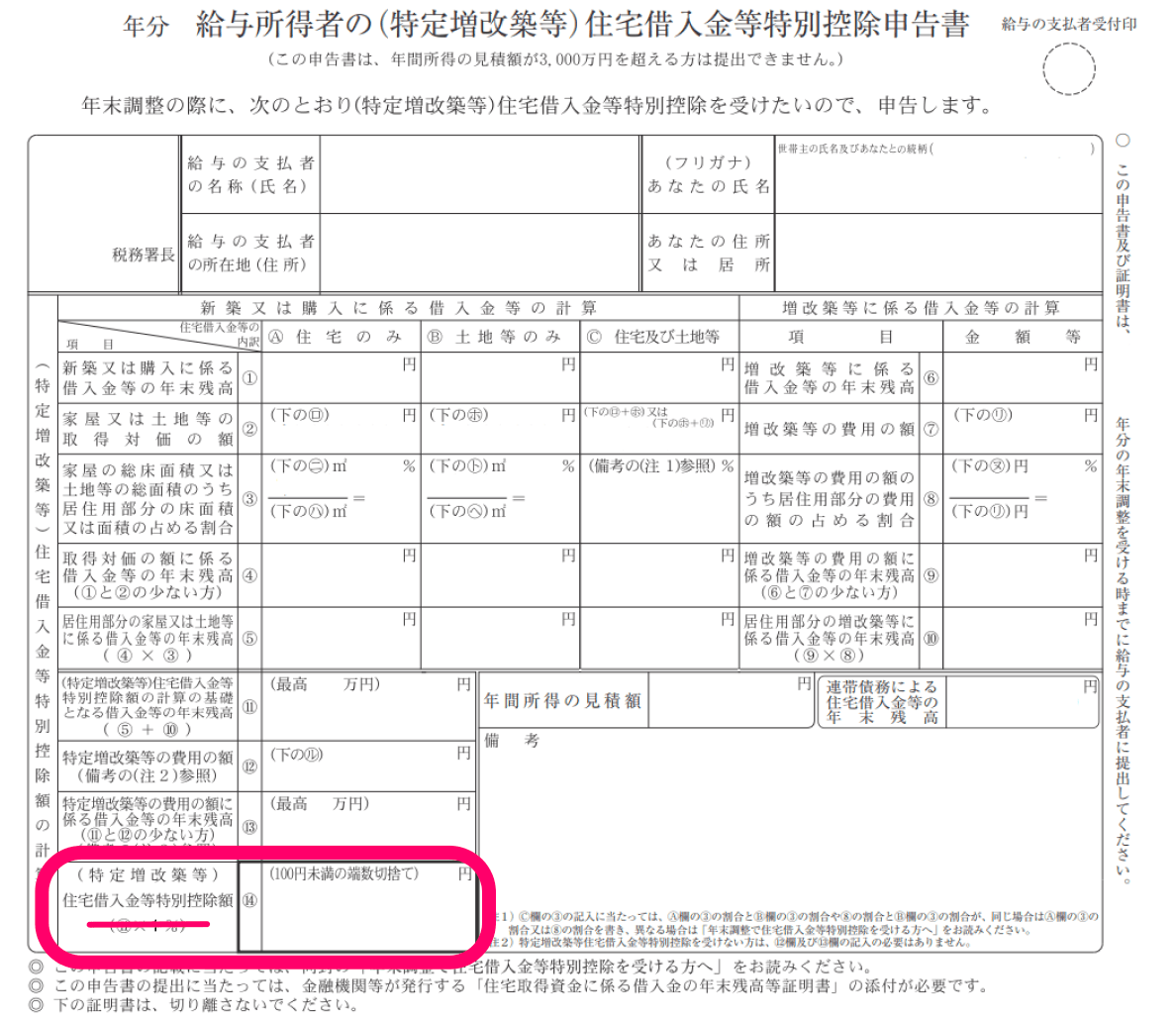 画像を表示する
画像を表示する
(*7) If an amount is listed under “特定増改築等の費用の額” (Sum of expenses for specific improvements or additions)
Applies if there is a figure printed in the sections circled in red.
| Format after 2020 | Format before 2020 |
|---|---|
 画像を表示する 画像を表示する | 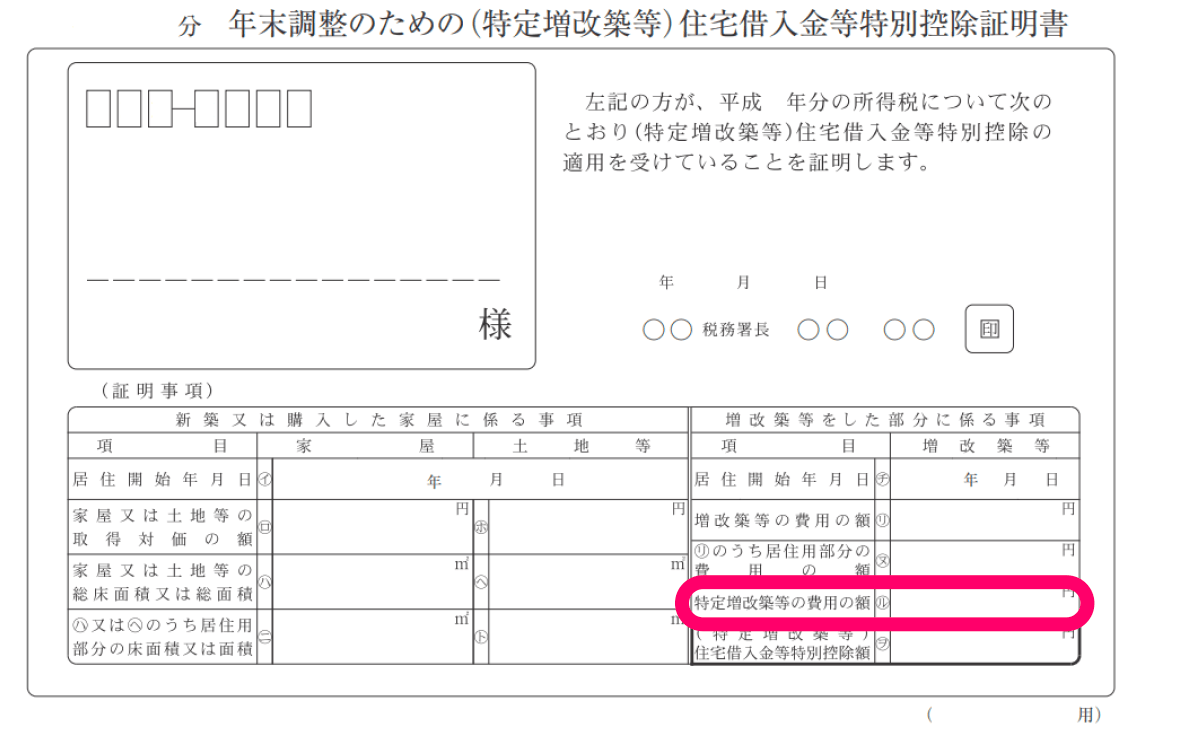 画像を表示する 画像を表示する |
Three cases where questionnaire responses make an employee ineligible to create the application
Based on the answers to the year-end adjustment questions, our system determines whether a home loan deduction application form should be created for the employee. If you are unable to create the application form despite having a housing loan, please check your answers to the following three questions in the questionnaire. If any of the following apply, you will not be able to create the application form via SmartHR.
- Question 200: Answered [No] to “Would you like to declare housing loan deductions via year-end adjustment? (年末調整で住宅ローン控除を申告しますか?)”
- Question 201: Answered [I am not eligible] on the page that says “This is to check whether the housing loan deductions application can be created on SmartHR” (SmartHRで住宅ローン控除申告書を作成できるかどうか確認します)
- Question 217: Pressed [Next] on the page that says “If both Columns イ (I) and チ (Chi) have dates in them, you cannot create a housing loan deductions application via SmartHR” (イ欄とチ欄の両方に日付がある場合、SmartHRで住宅ローン控除申告書を作成できません)
- Question 217 is shown only if [Listed in both fields (イ) and (チ)] (イ欄とチ欄の両方にある) is chosen as the answer concerning the date in question 215 or question 245.
What to do if you cannot create the application via SmartHR
Even if SmartHR can’t create their Housing Loan Tax Credit declaration, the employee must still fill out the declaration and submit the original documents. For details, refer to the below help page. Q. 住宅ローン控除申告書の作成対象外となった従業員への対応方法は?
